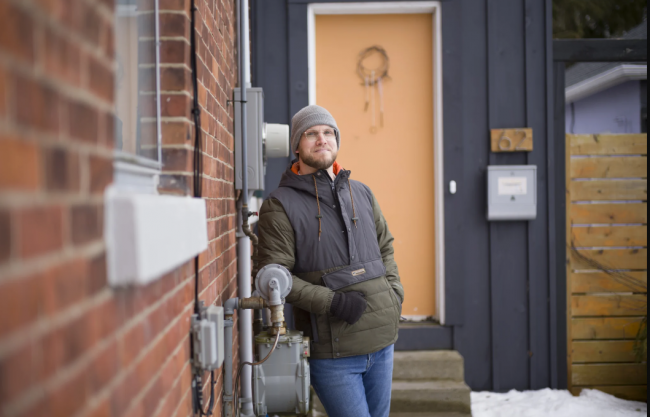Energy giant Enbridge is plotting a multibillion-dollar expansion to its gas network in Ontario that would lock the province into a fossil fuel future for decades to come.
In a 7,000-plus-page application, the Calgary-based fossil fuel company is asking the Ontario Energy Board to approve a rate hike for customers that would fund a dramatic spending increase to expand its gas network with new pipes across the province. A decision is not expected until late 2023, but through the rest of this year, an intense battle over the future of Ontario’s gas infrastructure is expected to heat up.
The fight over new gas hookups comes as jurisdictions across the country take steps to phase out fossil fuel heating to help meet climate goals. In late 2021, Quebec banned oil-powered heating in new homes, and by the end of this year, the province won’t allow furnaces to be replaced with any fossil fuel heating systems. As of last year, Vancouver requires zero-emission space and water heating in new low-rise buildings, and by 2025, the city will demand that all new and replacement heating systems be emissions-free.
Last year, the Ontario energy regulator shot down Enbridge’s plan to replace its gas pipeline for Ottawa, citing concerns the plan conflicts with the city’s plan to curb greenhouse gas emissions and the company’s failure to show replacing the pipeline was necessary.
Burning fossil fuels to heat buildings is one of Canada’s toughest challenges in the race to decarbonize, causing more greenhouse gas emissions than power generation or agriculture. In Ontario, buildings are the third-largest source of planet-warming pollution, responsible for a quarter of the province’s total. Beyond the known climate impacts, gas stoves are also increasingly linked to diseases like asthma in children.
Concerns over the health and climate impacts of gas motivated Drew Tozer to electrify his 100-year-old house in Port Hope, Ont. Tozer bought the house in 2020 and soon fell down a decarbonization rabbit hole in his effort to rid his house of fossil fuels, eventually trading in a career in renewable energy and conservation programs to become a full-time energy adviser with his newly formed company Shepherd Building Science. He now helps others improve the efficiency and carbon footprint of their homes.

Tozer officially closed his Enbridge account in November and told Canada’s National Observer there are similarities between the gas giant’s plan to lock the province into a fossil-fuelled future and the challenges he faced weaning his home off gas.
“Most contractors you talk to along the way in a project like this are all trying to steer you back towards gas,” rather than to electric or energy-efficient options, he said. For example, contractors would push a gas fireplace instead of a woodstove or a gas furnace instead of a heat pump, Tozer said. “I think a lot that is just what they're used to installing, and so they try to sell what they're comfortable with.”
A homeowner who shells out to replace one gas furnace with a newer model is unlikely to invest in a cleaner option, Tozer said. “It's a much bigger barrier at that point to decide to electrify your home if it involves ripping out or removing a large piece of equipment that you just paid to replace.”
Energy giant Enbridge is plotting a multibillion-dollar expansion to its gas network in Ontario that would lock the province into a fossil fuel future for decades to come. #ONpoli - Twitter
That’s a microcosm of Enbridge’s gas network expansion plans in Ontario, and a smarter choice would be to consider other options, Tozer said.
The detailed and highly technical application now before the Ontario regulator shows Enbridge is proposing an expansion to its gas network that will require collecting more than $16 billion from customers over the coming years to pay for the new pipes, as well as operating and maintenance costs. If given the green light, the plan includes replacing existing pipes and installing new ones to connect new areas of the province to the gas network.
The regulatory process will have enough information to examine each proposed pipe Enbridge plans to put in the ground, but a better approach is to step back and look at the big picture, said Kent Elson, a lawyer representing the non-profit Environmental Defence that is intervening in Enbridge's application.
“That's a lot of money for fossil fuel infrastructure,” he told Canada's National Observer, particularly when gas pipelines and other infrastructure are expected to last until 2070 and beyond — well past the point when fossil fuels must be phased out to avoid disastrous global warming.
At this stage in the regulatory process, nothing in Enbridge’s plan is guaranteed. The energy company, which serves 98 per cent of Ontario’s gas demand following a merger with Union Gas in 2018, is just laying out its proposed plan for the coming years. This document spells out where it wants to invest money, how it expects demand to change and the rates it wants to charge customers to pay for its expansion.
Depending on the region of the province, the average customer can expect annual increases of between $28 and $193 to their bills starting next year if Enbridge’s request is approved.
In documents filed with the regulator, Enbridge says it expects demand for gas to grow in Ontario to justify the expansion. It based its assumption on projected municipal housing starts, population forecasts and other economic indicators. Enbridge notes “there may be impacts to customer growth forecasts based on climate/carbon policies” but does not say those considerations have been incorporated into its plans.
“One of the really scary things for customers is if there is continued demand for the next five years but then it drops off,” Elson said. If demand drops, Enbridge’s revenue drops, meaning it won’t be able to pay for the pipeline. “So you need to be considering not only the demand of the next couple of years but also the demand for the entire lifetime over which you're predicting to earn revenue for this pipeline.”
Enbridge told Canada’s National Observer it is committed to net zero by 2050 and aims to cut 35 per cent of its emissions by 2030 by investing in green technologies and lower-carbon gases. The company commissioned a report included in its application that claims the most cost-effective way for Ontario to reach net zero would be through a “diversified” approach that sees continued fossil fuel burning made somewhat cleaner by using carbon capture technology and blending hydrogen and “renewable natural gas” into the network.
To credibly be on a path to a zero-emission future means phasing out all fossil fuels in favour of renewable energy to heat homes and buildings. Ontario’s target is to cut emissions from buildings 30 per cent below 2005 levels by 2030.
A 2020 report from the province’s auditor general found Ontario was at risk of missing that target by failing to put in place rules to curb fossil fuel burning or making it a cross-government priority.
“So that the Ontario Energy Board’s decisions support the government’s emission-reduction goals, we recommend that the Ontario Energy Board align its decisions with the environment plan and any other provincial climate change goals,” the auditor general’s office wrote as one recommendation to help bring down building emissions.
In the coming months, expert testimony to challenge Enbridge’s plans is expected to be filed with the regulator. Initial submissions with the regulator suggest pushback on Enbridge will focus on repairing (rather than replacing) pipelines to reduce costs and the risk of stranded assets, creating a new separate fund for pipeline abandonment costs to avoid the risk of the public picking up the cost and challenging the wisdom of new gas hookups in an era of decarbonization.

